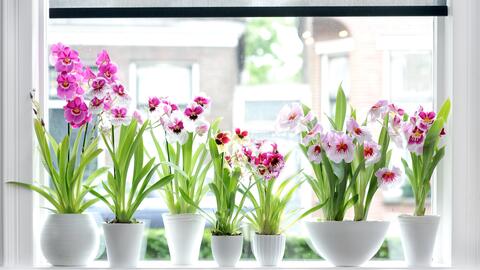How prune Orchids correctly: That’s how it’s done
The last Orchid blossom has dried up and fallen off. What’s next? To prune or not to prune? We give tips on pruning Orchids, starting from the right time and ending with the right procedure.

Everybody wants vibrantly blooming Orchids – but what do you do once the beautiful flowers are gone?
Amateur gardeners regularly ask themselves how and when to prune their indoor Orchids. Opinions range from "Never prune Orchids!" to "Cut off everything that isn’t flowering!". The results in the first case bare Orchids countless "octopus arms" and in the second case plants with very long regenerative rest periods. Therefore we explain and summarize the most important rules of thumb for pruning Orchids.
When cared for properly, Orchids bloom abundantly and gloriously. Over time the flowers dry up and gradually fall off by themselves. What remains is a somewhat vibrant green stem. Whether you should cut this stem depends primarily on the type of Orchid you have in front of you. Single spike Orchids, such as representatives of the genus Venus Slipper (Paphiopedilum) or Dendrobium Orchids only grow flowers on one new spike. Since no further blooming can be expected on a flowered stem, the spike can be cut off directly at the base after the last blossom has fallen.

Orchids with several spikes, including the popular Phalaenopsis and some Oncidium varieties, are also known as "revolver flowers". With them, it is possible for a flowered stem to sprout again. In this case it has been proven that it is best to remove the spike not quite at the base, but above the second or third eye and to wait. With a little luck and patience, the flower spike will sprout again from the upper eye. It can generally rebloom two or three times before the spike dies.
Irrespective of the Orchid type: If a spike turns brown on its own and dries up, it can be cut off at the base without hesitation. Sometimes only one spike dries up, while the main spike remains healthy. In this case, only the withered piece should be cut off, but the green spike should be left standing or, if the main spike is no longer flowering, the whole spike should be pruned back to the third eye.
Some neglected Orchids (for example, office plants) tend to form one or two flowers at the end of the same spike over and over again. But the Orchid never really seems to bloom properly. The sparse blossom doesn’t look good and at the same time it prevents the plant from regenerating. In this case the affected spike should be pruned back boldly. A new spike – possibly in combination with a little Orchid fertilizer – will result in an abundance of flowers.
Orchid leaves generally do not require pruning. In the process of normal plant aging, every now and then a leaf turns yellow, becomes wrinkled and dries up. Leave the leaf on the plant until the plant parts gives it up itself or, in other words, until it can be removed with a slight tug. Leaves that are fleshy, green and juicy should only be removed at the base in an extreme emergency (e.g. disease). Never cut off an Orchid leaf only partially. The large cut surface acts as an entry point for all kinds of pests.

When an Orchid is repotted, the roots should also be cleaned out. Remove the Orchid substrate and examine your Orchid’s root system. Then cut back dried and rotten roots with sharp shears. Healthy, green Orchid roots should not be removed, nor should aerial roots. Even if the long tentacles of sit-on plants are sometimes visually disturbing, cutting them off unnecessarily weakens the plant.
One Exception: If you’re dealing with an Orchid that has been struggling or was poorly cared for, a light root pruning can stimulate growth - so in this case, it is worth a try.

If you prune your Orchid with shears, make sure that they are clean and as sharp as possible before you do so. A good knife or scalpel is usually more suitable for pruning Orchids than shears. Disinfect the pruning tool with methylated spirits or boiling water before using it. Also take care not to damage surrounding roots, leaves or stems when pruning.

The Orchid was cut back and now it shows no sign of life? Don’t worry, it’s perfectly normal. After flowering abundantly, some species and varieties of Orchid take a break to regenerate; this can last several weeks or months. During this "hibernation" neither new spikes nor leaves are formed, the plant appears to be frozen. The Orchid needs less water and no fertilizer during its regeneration period. It can then also be placed in a slightly cooler place, for example in the bedroom. Only when a new flower spike sprouts should the Orchid be carefully fertilized again and watered more intensively..






